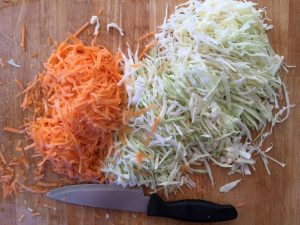We have a pretty fixed view of what makes up the human body – cells, blood, tissues, bone and so on. But, did you know that inside your gut you carry around a whopping 2kg of microbes, which consists of over 1,000 different species of bacteria that outnumber our cells 10 to 1? Most of us are aware that these bacteria play a hugely important role in the digestion process (breaking down food, absorbing nutrients etc), but science is increasingly viewing the microbiome as a new, unexplored and possibly intelligent organ in its own right. Scientists are now asking: what’s the connection between the health of our microbiome and our overall health? What role does the microbiome play in mood, depression, diabetes, autism, autoimmune disease, inflammation, food allergies and cancer?
Though it’s an emerging field, scientists seem to agree that a diversity of gut bacteria is good for our health and that (not surprisingly) what we put in to our bodies has a huge impact on our microbiome. Diets high in processed foods are thought to have a huge impact on our gut micro-organism levels. Dietary sugar and fat encourages bad bacteria and reduces the level of the virtuous ones. Excessive antibiotic use is also a concern – a study co-led by researchers at the Universitat de València found that antibiotic treatment causes significant and sometimes irreversible changes in our gut community. Specifically, the study found that the gut microbiome shows less capacity to absorb iron and digest certain foods during antibiotic treatment.
There are major health claims being made about fermented foods in relation to gut heath, some of which we should probably treat with caution. They are purported to improve intestinal tract health, enhance the immune system, improve absorption of nutrients and reduce the risk of certain cancers. Scientists agree that the bacteria in fermented foods help to pre-digest food components, making it easier for your gut to handle and for nutrients to be absorbed.
When I first started fermenting food at home, I was more interested in how they could help me to ‘store’ food than I was in their potential health benefits. Kimchi and sauerkraut for example are centuries-old methods (in Korea and Germany respectively) of preserving cabbage. From a culinary perspective I think kimchi is the more exciting of the two. In Korea there are thought to be literally thousands of kimchi recipes and it was traditionally stored in clay pots buried underground to keep them cool and slow the fermentation process. My version below adds carrot, beetroot and shallots as well as the traditional garlic, ginger and chilli-pepper to give it a kick. I have got in to the habit of eating a small bowl of kimchi each evening before dinner (or sometimes as a side dish). Potential gut health benefits aside, it’s a delicious way to deal with a glut of homegrown veg.
Read more about the microbiome and health here: http://learn.genetics.utah.edu/content/microbiome/disease
GROW HQ
The home of the GIY movement and our brand new national food education centre, GROW HQ, is finally open in Waterford city. In addition to our 65-seat home-grown food café and shop, we’ve a range of growing and cooking courses happening weekly – for courses happening this month, check out www.growhq.org.
Things to do this Month – November
To Do
Do not leave beds bare for the winter – sow a green manure, or cover with a thick layer of manure/compost and then black plastic or straw. This will return nutrients to the soil, keep the worst of the weather off it, suppress weeds and prevent leaching of nutrients. ‘Earth up’ or tie up vegetables such as cabbage, cauliflower and Brussels sprouts. Divide up your rhubarb if you want to propagate, and cover it with a thick mulch of manure. Prune apple trees. Mulch fruit bushes. Take cuttings of currant bushes from current season’s wood.
Sow
Sow broad beans outside now for an early crop next spring. To avoid rotting before germination, make small newspaper cups and germinate them indoors first. Next summer’s garlic does best if it’s planted before Christmas – plant outdoors in well prepared soil in a sunny spot. Though I have to admit I never bother with them, some varieties of onion can over-winter and will be ready to harvest in early summer.
Harvest
Continue to harvest perpetual spinach, cabbage, cauliflower, potatoes, swede, parsnips, apples, pears. Start harvesting leeks, winter cabbage, kale, artichokes, Brussels sprouts. Time to lift carrots and turnips or at least cover them with a good layer of straw to protect them from frost damage.
Recipe of the Month – Kimchi
Though it’s traditional to have coarsely grated cabbage in kimchi, I like the veg to be finely grated. This recipe produces enough for two large kilner jars, but a lot will depend on the size of the head of cabbage!
Ingredients
• 1 Medium head white cabbage, grated
• 2 medium carrots, grated
• 1 small beetroot, peeled and grated
• 3 shallots , chopped
• 2 red chillis deseeded and finely chopped
• Thumb-sized piece ginger, chopped
• 2 tbs fish sauce
• 750ml water and 3 tbs sea salt
Directions
Make the brine by adding the salt to the water and stirring. Put the cabbage, beetroot and carrot in a large bowl and add the brine. Put a plate on top to keep the veg submerged and leave 3-4 hours or overnight. Drain the veg the next morning, retaining the brine. Put the shallots, chillis, ginger and fish sauce and blitz with a hand-blender until it’s like a paste. Pour over the veg and mix really well to ensure all the veg is coated in the paste. Put the veg mix in to sterilised kilner jars and pour the brine over so it’s covering the veg. Cover and leave to stand at room temperature for 3-5 days. It will start to bubble and ferment. Then pop it in the fridge where it will continue to ferment (but more slowly). You can enjoy it straight away and it will keep for about a month (though it never lasts that long in our house).
Tip of the Month – Ventilate
As the cold weather and lower light conditions draw in, it’s important to close up the doors of your greenhouse or polytunnel to keep the heat in there as much as possible. However try and give the polytunnel/greenhouse a good airing on fine dry days – open up the doors and let air circulate – this will help to stop disease developing, particularly downy mildew which can be a big issue in the winter months. On days where you do open up the doors make sure to close them again at night to retain whatever heat is in there.
Join GIY
By joining GIY you help us to continue the work of supporting people just like you to grow food at home, at school, in the workplace and in the community – this year we will support over 150,000 people and 4,500 community food growing groups and projects. It costs just €35 to join GIY for a year, and to say thanks we will send you a seasonal copy of our supporter’s magazine GROW and some GIY seeds for you to sow each quarter. Join today at www.giyireland.com.
Michael Kelly is a freelance journalist, author and founder of GIY.
© GIY Ireland 2016 – all rights reserved.





